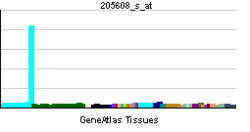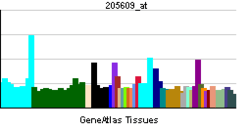Angiopoietin 1
Angiopoietin 1 is a type of angiopoietin and is encoded by the gene ANGPT1.
Angiopoietins are proteins with important roles in vascular development and angiogenesis. All angiopoietins bind with similar affinity to an endothelial cell-specific tyrosine-protein kinase receptor. The protein encoded by this gene is a secreted glycoprotein that activates the receptor by inducing its tyrosine phosphorylation. It plays a critical role in mediating reciprocal interactions between the endothelium and surrounding matrix and mesenchyme. The protein also contributes to blood vessel maturation and stability, and may be involved in early development of the heart.[1]
Interactions
Angiopoietin 1 has been shown to interact with TEK tyrosine kinase.[2][3][4][5]
See also
References
- ↑ "Entrez Gene: ANGPT1 angiopoietin 1".
- ↑ Fiedler, Ulrike; Krissl, Tanja; Koidl, Stefanie; Weiss, Cornelia; Koblizek, Thomas; Deutsch, Urban; Martiny-Baron, Georg; Marmé, Dieter; Augustin, Hellmut G (Jan 2003). "Angiopoietin-1 and angiopoietin-2 share the same binding domains in the Tie-2 receptor involving the first Ig-like loop and the epidermal growth factor-like repeats". J. Biol. Chem. (United States) 278 (3): 1721–7. doi:10.1074/jbc.M208550200. ISSN 0021-9258. PMID 12427764.
- ↑ Davis, S; Aldrich, T H; Jones, P F; Acheson, A; Compton, D L; Jain, V; Ryan, T E; Bruno, J; Radziejewski, C; Maisonpierre, P C; Yancopoulos, G D (Dec 1996). "Isolation of angiopoietin-1, a ligand for the TIE2 receptor, by secretion-trap expression cloning". Cell (United States) 87 (7): 1161–9. doi:10.1016/S0092-8674(00)81812-7. ISSN 0092-8674. PMID 8980223.
- ↑ Sato, A; Iwama A; Takakura N; Nishio H; Yancopoulos G D; Suda T (Aug 1998). "Characterization of TEK receptor tyrosine kinase and its ligands, Angiopoietins, in human hematopoietic progenitor cells". Int. Immunol. (ENGLAND) 10 (8): 1217–27. doi:10.1093/intimm/10.8.1217. ISSN 0953-8178. PMID 9723709.
- ↑ Maisonpierre, P C; Suri, C; Jones, P F; Bartunkova, S; Wiegand, S J; Radziejewski, C; Compton, D; McClain, J; Aldrich, T H; Papadopoulos, N; Daly, T J; Davis, S; Sato, T N; Yancopoulos, G D (Jul 1997). "Angiopoietin-2, a natural antagonist for Tie2 that disrupts in vivo angiogenesis". Science (UNITED STATES) 277 (5322): 55–60. doi:10.1126/science.277.5322.55. ISSN 0036-8075. PMID 9204896.
Further reading
- Nakajima D, Okazaki N, Yamakawa H, (2003). "Construction of expression-ready cDNA clones for KIAA genes: manual curation of 330 KIAA cDNA clones". DNA Res. 9 (3): 99–106. doi:10.1093/dnares/9.3.99. PMID 12168954.
- Metheny-Barlow LJ, Li LY (2004). "The enigmatic role of angiopoietin-1 in tumor angiogenesis". Cell Res. 13 (5): 309–17. doi:10.1038/sj.cr.7290176. PMID 14672554.
- Makinde T, Murphy RF, Agrawal DK (2007). "Immunomodulatory role of vascular endothelial growth factor and angiopoietin-1 in airway remodeling". Curr. Mol. Med. 6 (8): 831–41. doi:10.2174/156652406779010795. PMID 17168735.
- Nomura N, Miyajima N, Sazuka T, (1995). "Prediction of the coding sequences of unidentified human genes. I. The coding sequences of 40 new genes (KIAA0001-KIAA0040) deduced by analysis of randomly sampled cDNA clones from human immature myeloid cell line KG-1". DNA Res. 1 (1): 27–35. doi:10.1093/dnares/1.1.27. PMID 7584026.
- Nomura N, Miyajima N, Sazuka T, (1995). "Prediction of the coding sequences of unidentified human genes. I. The coding sequences of 40 new genes (KIAA0001-KIAA0040) deduced by analysis of randomly sampled cDNA clones from human immature myeloid cell line KG-1 (supplement)". DNA Res. 1 (1): 47–56. doi:10.1093/dnares/1.1.47. PMID 7584028.
- Rüegg C, Pytela R (1995). "Sequence of a human transcript expressed in T-lymphocytes and encoding a fibrinogen-like protein". Gene 160 (2): 257–62. doi:10.1016/0378-1119(95)00240-7. PMID 7642106.
- Davis S, Aldrich TH, Jones PF, (1997). "Isolation of angiopoietin-1, a ligand for the TIE2 receptor, by secretion-trap expression cloning". Cell 87 (7): 1161–9. doi:10.1016/S0092-8674(00)81812-7. PMID 8980223.
- Suri C, Jones PF, Patan S, (1997). "Requisite role of angiopoietin-1, a ligand for the TIE2 receptor, during embryonic angiogenesis". Cell 87 (7): 1171–80. doi:10.1016/S0092-8674(00)81813-9. PMID 8980224.
- Maisonpierre PC, Suri C, Jones PF, (1997). "Angiopoietin-2, a natural antagonist for Tie2 that disrupts in vivo angiogenesis". Science 277 (5322): 55–60. doi:10.1126/science.277.5322.55. PMID 9204896.
- Ristimäki A, Narko K, Enholm B, (1998). "Proinflammatory cytokines regulate expression of the lymphatic endothelial mitogen vascular endothelial growth factor-C". J. Biol. Chem. 273 (14): 8413–8. doi:10.1074/jbc.273.14.8413. PMID 9525952.
- Cheung AH, Stewart RJ, Marsden PA (1998). "Endothelial Tie2/Tek ligands angiopoietin-1 (ANGPT1) and angiopoietin-2 (ANGPT2): regional localization of the human genes to 8q22.3-q23 and 8p23". Genomics 48 (3): 389–91. doi:10.1006/geno.1997.5207. PMID 9545648.
- Witzenbichler B, Maisonpierre PC, Jones P, (1998). "Chemotactic properties of angiopoietin-1 and -2, ligands for the endothelial-specific receptor tyrosine kinase Tie2". J. Biol. Chem. 273 (29): 18514–21. doi:10.1074/jbc.273.29.18514. PMID 9660821.
- Sato A, Iwama A, Takakura N, (1998). "Characterization of TEK receptor tyrosine kinase and its ligands, Angiopoietins, in human hematopoietic progenitor cells". Int. Immunol. 10 (8): 1217–27. doi:10.1093/intimm/10.8.1217. PMID 9723709.
- Valenzuela DM, Griffiths JA, Rojas J, (1999). "Angiopoietins 3 and 4: diverging gene counterparts in mice and humans". Proc. Natl. Acad. Sci. U.S.A. 96 (5): 1904–9. doi:10.1073/pnas.96.5.1904. PMC 26709. PMID 10051567.
- Grosios K, Leek JP, Markham AF, (1999). "Assignment of ANGPT4, ANGPT1, and ANGPT2 encoding angiopoietins 4, 1 and 2 to human chromosome bands 20p13, 8q22.3→q23 and 8p23.1, respectively, by in situ hybridization and radiation hybrid mapping". Cytogenet. Cell Genet. 84 (1–2): 118–20. doi:10.1159/000015235. PMID 10343124.
- Procopio WN, Pelavin PI, Lee WM, Yielding NM (1999). "Angiopoietin-1 and -2 coiled coil domains mediate distinct homo-oligomerization patterns, but fibrinogen-like domains mediate ligand activity". J. Biol. Chem. 274 (42): 30196–201. doi:10.1074/jbc.274.42.30196. PMID 10514510.
- Huang YQ, Li JJ, Karpatkin S (2000). "Identification of a family of alternatively spliced mRNA species of angiopoietin-1". Blood 95 (6): 1993–9. PMID 10706866.
- Kim I, Kim JH, Ryu YS, (2000). "Characterization and expression of a novel alternatively spliced human angiopoietin-2". J. Biol. Chem. 275 (24): 18550–6. doi:10.1074/jbc.M910084199. PMID 10766762.
- Dunk C, Shams M, Nijjar S, (2000). "Angiopoietin-1 and angiopoietin-2 activate trophoblast Tie-2 to promote growth and migration during placental development". Am. J. Pathol. 156 (6): 2185–99. doi:10.1016/S0002-9440(10)65089-4. PMC 1850068. PMID 10854239.
- Krikun G, Schatz F, Finlay T, (2000). "Expression of angiopoietin-2 by human endometrial endothelial cells: regulation by hypoxia and inflammation". Biochem. Biophys. Res. Commun. 275 (1): 159–63. doi:10.1006/bbrc.2000.3277. PMID 10944458.
This article incorporates text from the United States National Library of Medicine, which is in the public domain.
| ||||||||||||||||||||||||||||||||

